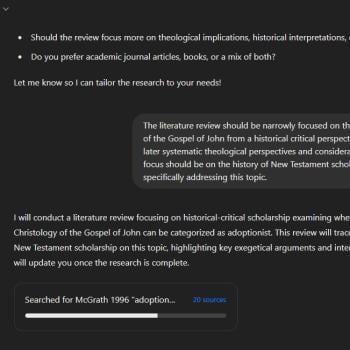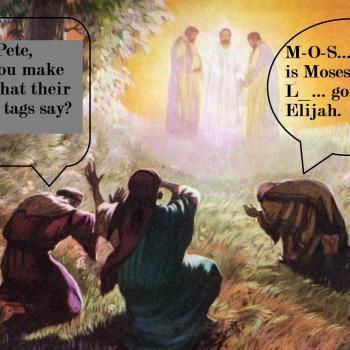I recently had the opportunity to read an advance copy of Daniel Kirk’s forthcoming book, which he blogged about recently. The book is called A Man Attested by God: The Human Jesus of the Synoptic Gospels. I cannot emphasize enough what an important study this is. I am hopeful that it will radically shift the direction of the field, and put an end to facile and unpersuasive claims that this or that in the Synoptic Gospels reflects the depiction of Jesus as himself in some sense the one God of Israel. Here is what I wrote by way of endorsement:
This may be the most important book in Christology to appear in recent years. Written in an era when it has become increasingly popular to insist that Jesus is already depicted as a pre-existent figure in the Synoptic Gospels, one who is absorbed into the “divine identity,” Daniel Kirk makes a persuasive case for viewing the depiction of Jesus in Matthew, Mark, and Luke as one of idealized humanity. Unlike many other proposals, this category, and this volume in which it is proposed, does good justice to the evidence, and is likely to stand the test of time.
It is a common tactic for defenders of the divinity of Jesus to insist that, although Christian authors do not spell out the details of the doctrine of the Trinity, they indicate it (some would say subtly, some would say clearly) through things such as the use of one preposition for both the Father and Jesus. For instance, Bill Mounce recently made this claim on the Zondervan blog. Presumably the worship of God and the king in Chronicles (one verb, two objects) indicated the divinity of Solomon too, right? Kirk’s book addresses these issues fantastically well, and shows that idealized humanity is the category that fits the evidence best. Here’s a sample:
Idealized human figures are a wide-spread and wide-ranging reality in the literature of early Judaism. This is so both in the soft sense of persons or communities who are depicted as chosen by God or ideally pious, and in the stronger sense of human beings of the past, present, or idealized future who are depicted with actions, ascriptions, or attributes that are typically reserved for God alone. The textual data of early Judaism provides overwhelming evidence against the notion that a theological commitment to monotheism placed significant restrictions on how a faithful Jew might depict a human hero…a good deal of what is often taken to be “high Christology” in the sense of divine Christology actually has antecedents in idealized human figures, and thus is a high, human Christology. The widespread phenomena of idealized human figures suggests both that many scholars have jumped too quickly to the assumption that divinity of some sort is entailed in some of the earliest depictions of Jesus, and that the quest for parallels among angelic or other celestial figures might be less fruitful than has often been hoped. Specifically at this point return to the arguments of Richard Bauckham, who looked for parallels to his “divine identity Christology” among angels, but found that they, for instance, serve rather than rule. In the final analysis, his argument fails to prove his case not only because the data directly contradicts it (as he himself notices with regard to 1 Enoch) but also because he tried to prove the point from the wrong set of data. It is more often idealized human figures, not angels, who bear the divine identity through actions, ascriptions, or attributes otherwise reserved for God alone.
Here is another extract from nearby, which I think likewise gets at the heart of the book’s conclusions:
[B]eing identified with God is not the same as being identified as being God…Despite the assertions of some early Jewish writers, we discover a notable absence of anxiety about applying divine attributes to people in both biblical and post-biblical Judaism. This is a crucial point in parsing many of the arguments about biblical Christology, particularly those that lean on a divine identity Christology or some variation of it. The theological conviction about Israel’s one God is, of course, important to Israel’s daily piety and practice. That such a conviction is firmly rooted is undeniable. The significance of this conviction in delimiting what can or cannot be said about other creatures, however, can only be known through a study of early Jewish representations of these others. This chapter demonstrates that for many Jewish writers across a wide span of years and of Jewish conviction, the confession of God’s oneness sat easily alongside the identification of their own heroes with this God…Jewish monotheism plays little role in limiting how Jewish writers can depict (human) figures whom they or their communities recognize as being specially endowed for some task or function. Indeed, an opposite inclination seems to be at work: it is precisely through depicting some human figure through ascriptions, actions, or attributes otherwise indicative of the identity of God that early Jewish writers signal that God has given these humans crucial roles to play in the past, present, or idealized future.
The above is just a small sampling from pp.269-272. The book is very long and detailed, and extremely rich, precise, and nuanced. I cannot adequately convey just how important a contribution to New Testament Christology this is, and I strongly advise that you just go ahead and pre-order it on Amazon.
See also Dale Tuggy’s podcasts #128, 129, and 130 on Bart Ehrman and Michael Bird‘s exchanges concerning how Jesus became God, Daniel Boyarin’s lectures on Enoch, Jesus, and Metatron, Allan Bevere’s series on post-NT Christology, and Christopher Skinner’s video about his book, Reading John. In case you missed it, Jacob Prahlow’s Biblical Studies Carnival included some of the posts on Mark’s Christology as one of the highlights of the month.
Dustin Smith was involved in a debate about the pre-existence of Jesus recently:
https://www.youtube.com/watch?v=EQ1RkLEBIEEDustin Smith also recently explained why he believes the New Testament depicts the Father as the only true God – while eating!













